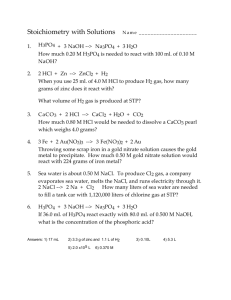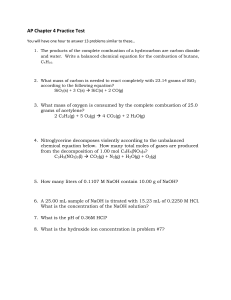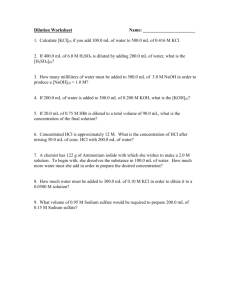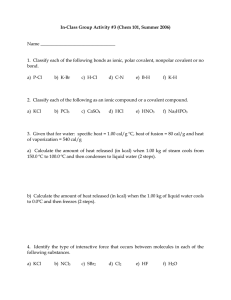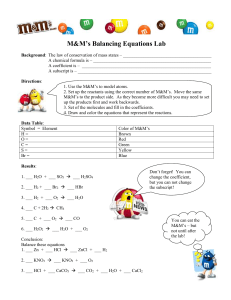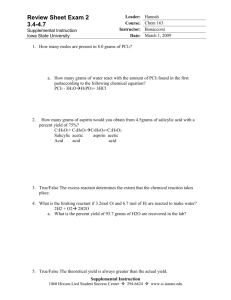Final Review Worksheet Chem 101, Summer 2006
advertisement
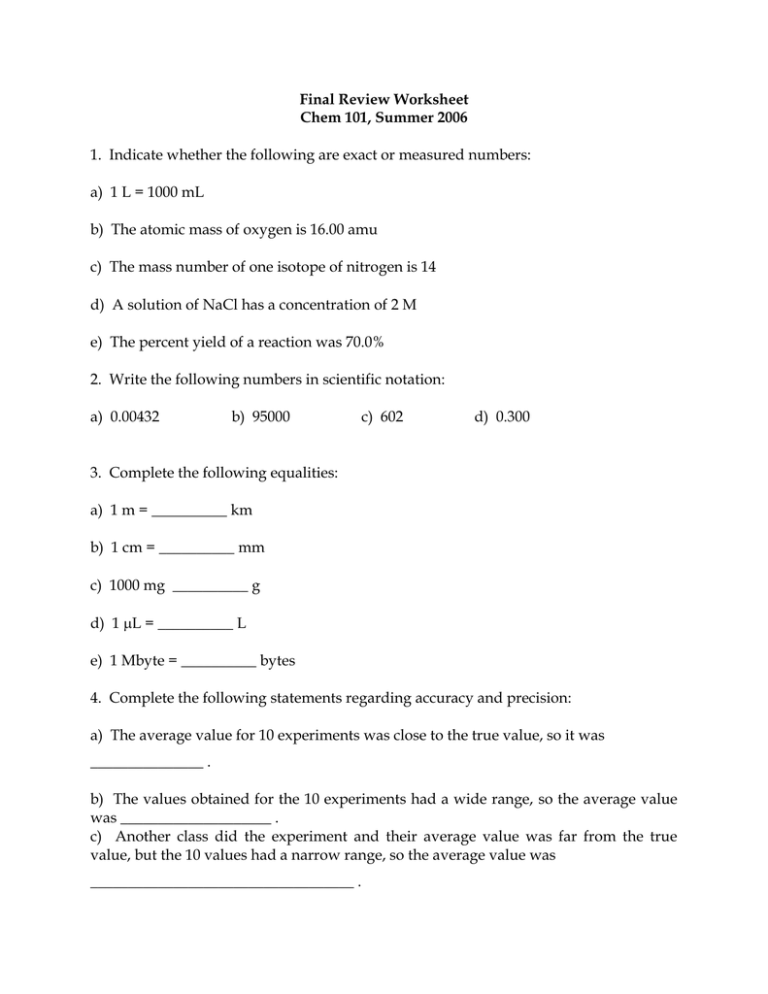
Final Review Worksheet Chem 101, Summer 2006 1. Indicate whether the following are exact or measured numbers: a) 1 L = 1000 mL b) The atomic mass of oxygen is 16.00 amu c) The mass number of one isotope of nitrogen is 14 d) A solution of NaCl has a concentration of 2 M e) The percent yield of a reaction was 70.0% 2. Write the following numbers in scientific notation: a) 0.00432 b) 95000 c) 602 d) 0.300 3. Complete the following equalities: a) 1 m = __________ km b) 1 cm = __________ mm c) 1000 mg __________ g d) 1 L = __________ L e) 1 Mbyte = __________ bytes 4. Complete the following statements regarding accuracy and precision: a) The average value for 10 experiments was close to the true value, so it was _______________ . b) The values obtained for the 10 experiments had a wide range, so the average value was ____________________ . c) Another class did the experiment and their average value was far from the true value, but the 10 values had a narrow range, so the average value was ___________________________________ . 5. Water is 11.2% by mass hydrogen and 88.8% by mass oxygen. a) How many grams of water would contain 5.0 g of hydrogen? b) How many grams of water would contain 2.25 kg of oxygen? 6. If 10.0 mL of water and 10.0 mL of olive oil are placed in a 100 mL graduated cylinder and then stirred vigorously, a) What kind of mixture do they form? b) Some time later the mixture has separated. Which substance is on top and why? c) If a 3.00 g piece of aluminum, which has a density of 2.70 g/mL, is placed in the cylinder, what is the new volume that you would read? 7. Give the name of the element represented by each of the following symbols: a) Si b) B c) Ag d) Pb e) Ca f) Br 8. Write the symbol for each of the following elements: a) Potassium b) Argon c) Tin d) Phosphorus e) Gold f) Iron 9. Complete the following statements about metals and nonmetals: a) _______________ are good conductors of heat. b) _______________ typically have low densities. c) When they form ions, metals typically _______________ electrons. d) Metals usually form _______________ bonds with nonmetals. e) A covalent bond is usually formed between a _______________ and a _______________ . 10. Make a sketch of an atom. neutrons. Show the locations of the electrons, protons and 11. If the atomic number is 17 and the mass number is 37, a) What is the element? b) How many electrons does it have? c) How many neutrons does it have? 12. The three isotopes of silicon have the following abundances: 4.70% and 30Si = 3.10%. What is the atomic mass of silicon? 13. Write the electron configuration for arsenic: 14. Indicate the element that meets the following conditions: a) Has 5 electrons in shell 3 b) Has four 3p electrons c) Is in group 7A and electrons in shell 5 28S = 92.2%, 29Si = d) Has 5 electrons, 3 of which are valence electrons 15. Why can the 3p subshell have a maximum of 6 electrons, while the 3s subshell can only have a maximum of 2 electrons? 16. Complete the following nuclear equations: a) 210Po 206Pb c) 235U + ? e) 88Br 87Br + ? 143Xe + 90Sr + 3 1n + ? b) 140La ? + 2 1n d) 196At 4He + ? f) 131I 131Xe + ? 17. Complete the following statements regarding alpha, beta and gamma emitters: a) _______________ emitters travel the farthest through tissue. b) Gloves, safety glasses and a labcoat are generally sufficient protection for working with _______________ emitters. c) Plexiglass provides good protection from _______________ emitters. 18. If the half-life of 131I is 8 days, how long will it take for a 300 Ci dose given to a patient take to decay to a safe level (say less than 40 Ci)? 19. Write the electron-dot structures for the following atoms, ions, ionic compounds and covalent compounds: a) N b) Li+ c) I- d) KBr e) CaCl2 f) H2O g) HCl h) CO2 i) PBr3 j) CH3OH k) OH- l) HCN 20. The dots in electron-dot structures represent _______________ electrons. 21. What is the octet rule? 22. Positive ions are formed when atoms _______________ electrons and negative ions are formed when atoms _______________ electrons. 23. Classify each of the following as an ionic or a covalent compound: a) Li2S b) CCl4 c) MgSO4 d) HCl e) C4H10 24. For each of the following compounds, give the name and the molecular geometry (shape), and classify each as polar or nonpolar overall: a) H2S b) CO2 c) BF3 d) PF3 e) SiCl4 f) HCl 25. Identify the type of attractive force that would occur between molecules of the following substances: a) Na2S b) Br2 c) CH3OH d) HF e) CHCl3 26. Identify which of each of the following pairs of compounds would have a higher boiling point: a) HCl or HF b) K2SO4 or H2SO4 c) PH3 or BH3 d) CS2 or H2S e) C2H6 or C4H8 f) CCl4 or CH2Cl2 g) Br2 or HBr h) CO2 or COS 27. The melting point of benzene is 5.5C and its boiling point is 80.1C. Draw a heating curve for benzene as it goes from 0C to 100C. Label the x and y axes, physical states and melting and boiling point on the graph. 28. If an ice cube tray holds 325 g of water, and the water is initially at 25C, how much heat (in kcals) must be removed in order to cool the water to 0C and then freeze it? (Given that for water: specific heat = 1.00 cal/g ºC, heat of fusion = 80 cal/g and heat of vaporization = 540 cal/g) 29. Balance the following chemical equations and identify the type, or types, or reaction: a) Mg(s) + N2(g) Mg3N2(s) b) Cl2(g) + KI(aq) KCl(aq) c) NaHCO3(s) HCl(aq) d) H2SO4(aq) + + Al(OH)3(s) + + Heat I2(s) NaCl(aq) + Al2(SO4)3(aq) CO2(g) + + H2O(l) H2O(l) 30. For the following redox reactions, identify what is being oxidized and what is being reduced: a) 2K + Br2 2KBr Oxidized _______ Reduced _______ b) 2AgNO3 + Cu Cu(NO3)2 + 2Ag Oxidized _______ Reduced _______ 31. Draw an energy diagram for a reaction that is endothermic and slow. a) Label the diagram with the following: x-axis (what does it represent?), y-axis (what does it represent?), reactant(s), product(s), transition state, activation energy (EA) and heat of reaction. b) Is heat released or absorbed ? c) What would happen if you added a catalyst to the reaction? d) Draw a line on the diagram to show how addition of a catalyst would change the diagram. e) If the reaction represented in the diagram were reversible, would the equilibrium favor reactants or products? f) If reversible, which way would the equilibrium shift if heat was added? 32. According to LeChâtelier’s principle, which way will the equilibrium of the reaction shown below be shifted under the following conditions? N2 (g) + 3H2 (g) 2NH3 (g) + 22 kcal a) NH3 is added b) heat is removed 33. 1.00 mol of Ca(OH)2 contains: a) How many moles of hydrogen? b) How many atoms of oxygen? c) How many grams of calcium? c) H2 is added 34. Consider the following reaction: Pb(NO3)2 + 2KCl PbCl2 + 2KNO3 a) If 3.00 grams of Pb(NO3)2 is reacted with sufficient KCl, how many grams of PbCl2 will be formed? b) How many grams of KCl are required to react with 3.00 g of Pb(NO3)2? c) If 2.0 moles each of Pb(NO3)2 and KCl are reacted, which is the limiting reactant? d) If the percent yield of the reaction in part (a) is 85%, what is the actual yield? 35. Consider the following reaction: PCl5 PCl3 + Cl2 a) Write the equilibrium expression: b) If Keq = 2 x 10-2, does the equilibrium favor reactants or products or neither ? c) If Cl2 is removed from the reaction, does the Keq get larger or smaller or neither ? 36. Complete the following statements regarding gases: a) At constant T and n, the pressure _________________ when V is increased. b) At STP, the moles of gas have to _________________ for V to increase. c) At constant V and n, the pressure _________________ when T is increased. d) At constant P and n, the density _________________ when T is increased. 37. If T and n are constant, what will be the new V of a balloon that is initially at 1.0 L and 1.0 atm if the P is increased to 10.0 atm? 38. A balloon with a volume is filled with 50.0 g of He gas at 25.0ºC and 1.00 atm. What is the volume of the He gas in the balloon? (R = 0.0821 L atm/mol K) 39. In a lab experiment, a 0.280 L glass container is filled with CO2 gas at 22.0ºC and 762 mmHg, and the mass of the CO2 in the container is measured to be 0.508 g, what is the experimentally determined molar mass of CO2? (R = 62.4 L mmHg/mol K) 40. What is the density (g/L) of hydrogen gas at STP? 41. A scuba diving tank with a volume of 10.0 L contains 10.0 moles He gas and 20.0 moles O2 gas at 25.0ºC. a) What is the total pressure (in atm) in the tank? (R = 0.0821 L atm/mol K) b) What is the partial pressure of each gas in the tank? 42. Indicate whether each of the following substances are soluble in water: a) SiH4 b) HF c) CH3CO2H d) C3H8 e) Cu(NO3)2 f) KOH g) CaSO4 h) NaH2PO4 i) CaS j) PbCl2 k) Pb(CH3CO2)2 l) KBr 43. Write a balanced equation for the dissociation of the following strong electrolytes in water: a) CaCl2 b) K2SO4 44. NaCl has a solubility of 36.0 g/100 g H2O at 20ºC. How many grams of NaCl are needed to prepare a saturated solution using 250.0 mL of H2O? (density of H2O = 1.00 g/mL) 45. KCl has a solubility of 42.6 g/100 g H2O at 50.0ºC and 34.0g/100 g H2O at 20.0ºC. If a saturated solution of KCl is made using 0.500 L of H2O at 50.0ºC and then cooled to 20.0ºC, how many grams of KCl will precipitate out of the solution? 46. How many liters of 10.0% (v/v) ethanol solution (such as wine) would provide 175 mL of ethanol? 47. If 10.0 g of KCl is dissolved in water to a total volume of 0.500 L, what is the molarity of the solution? 48. If you were in the laboratory, how would you prepare 250.0 mL of a 0.100 M solution of NaOH? 49. If you were in the laboratory, how would you prepare 1.0 L of a 5.0% (m/v) solution of NaCl? 50. Consider the following reaction: Mg (s) + 2HCl (aq) MgCl2 (aq) + H2 (g) a) How many grams of Mg are required to react with 50.0 mL of 2.00 M HCl? b) How many L of H2 gas will be produced when 0.100 L of a 6.0 M HCl solution reacts with sufficient Mg at STP? c) If 0.500 L of HCl solution reacts with sufficient Mg to produce 10.0 L of H2 gas at STP, what is the molarity of the HCl solution? 51. State whether the salt formed in each of the following reactions would make a neutral, basic or acidic solution when dissolved in water: a) KOH + HCl KCl + H2O b) NH3 + HBr NH4Br c) NaOH + CH3CO2H NaCH3CO2 + H2O 52. What would happen to a red blood cell that was placed into each of the following types of solution? a) hypotonic b) isotonic c) hypertonic 53. If you were in the laboratory, how would you isolate the NaCl from a mixture containing the following substances: water and small amounts of NaCl, CaCO 3 and starch? (Hint: requires 3 steps) 54. Give the conjugate base for each of the following Brønstead-Lowry acids: a) HNO3 b) H3O+ c) H2PO4- d) NH3 55. Give the conjugate acid for each of the following Brønstead-Lowry bases: a) HCO3- b) SO42- 56. For the following reaction: c) NH3 d) H2O CH3CO2H + H2O CH3CO2- + H3O+ a) Identify which reactant is the acid and which is the base. b) Identify the conjugate acid and conjugate base. c) Write the equilibrium expression for the reaction. d) Ka = 1.8 x 10-5 for CH3CO2H. Does the equilibrium favor reactants or products ? e) Could you make a buffer with CH3CO2H? If so, what would you add besides CH3CO2H and H2O? 57. Will the conjugate base of H2SO4 be a strong base or a weak base ? 58. If 1.0 g of HCl is dissolved in H2O to a total volume of 250 mL, what is the pH of the solution? 59. Since H2O can act as either a weak acid or a weak base, it can react with itself. a) Write a balanced chemical equation for the reaction. b) Write the expression and give the value for Kw. c) Write the expression and give the value for pKw. 60. What is the pH of a neutral aqueous solution? 61. What is the concentration of OH- if the concentration of H3O+ = 1.0 x 10-5 M? 62. What is the pH of a solution that has a pOH of 5.50? 63. What is the pH of a solution that has an OH- concentration of 1.0 x 10-3 M? 64. Complete and balance the following reactions: a) Ca + HNO3 b) KHCO3 + HCl c) CH3CO2H + NaOH 65. A phosphate buffer is made by dissolving H3PO4 and NaH2PO4 in water. a) Write the equation that shows how the buffer would neutralize a small amount of added HCl (remember HCl + H2O H3O+ + Cl-): b) Write the equation that shows how the buffer would neutralize a small amount of added NaOH (remember NaOH Na+ + OH-): c) Calculate the theoretical pH of a buffer that is 0.15 M H3PO4 and 0.20 M H2PO4- (Ka for H3PO4 = 7.5 x 10-3). 66. How much H2O is needed to dilute 10.0 mL of 2.00 M NaOH to 0.500 M? 67. If it takes 25.0 mL of 0.250 M KOH to titrate 10.0 mL of HBr solution to the endpoint, what is the molarity of the HBr solution? 68. If it takes 15.0 mL of NaOH to titrate 20.0 mL of a 0.100 M solution of H2SO4 to the endpoint, what is the molarity of the NaOH?
